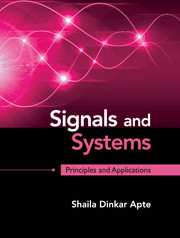Book contents
- Frontmatter
- Dedication
- Contents
- Preface
- 1 Introduction to Signals
- 2 Signals and Operations on Signals
- 3 CT and DT Systems
- 4 Time Domain Response of CT and DT LTI Systems
- 5 Fourier Series Representation of Periodic Signals
- 6 Fourier Transform Representation of Aperiodic Signals
- 7 Laplace Transform
- 8 Z Transform
- 9 Random Signals and Processes
- Index
1 - Introduction to Signals
Published online by Cambridge University Press: 05 May 2016
- Frontmatter
- Dedication
- Contents
- Preface
- 1 Introduction to Signals
- 2 Signals and Operations on Signals
- 3 CT and DT Systems
- 4 Time Domain Response of CT and DT LTI Systems
- 5 Fourier Series Representation of Periodic Signals
- 6 Fourier Transform Representation of Aperiodic Signals
- 7 Laplace Transform
- 8 Z Transform
- 9 Random Signals and Processes
- Index
Summary
We discuss the basic definitions of analog/continuous time (CT) and discrete time (DT) signals in this chapter. We need to understand the basics of discrete time signals, i.e., the sampled signals. The theory of sampled signals is introduced in this chapter. The analog signal is first interfaced to a digital computer via analog to digital converter (ADC). ADC consists of a sampler and a quantizer. We will mainly discuss the sampler in this chapter. The analog signal, when sampled, gets converted to discrete time (DT) signal. Here, the time axis is digitized with a constant sampling interval T. The inverse of T is the sampling frequency. The sampling frequency must be properly selected for faithful reconstruction of the analog signal.
Introduction to Signals
Any physical quantity that carries some information can be called a signal. The physical quantities like temperature, pressure, humidity, etc. are continuously monitored in a process. Usually, the information carried by a signal is a function of some independent variable, for example, time. The actual value of the signal at any instant of time is called its amplitude. These signals are normally plotted as amplitude vs. time graph. This graph is termed as the waveform of the signal. The signal can be a function of one or more independent variables. Let us now define a signal.
Definition of a signal A signal can be defined as any physical quantity that varies with one or more independent variables.
Let us consider temperature measurement in a plant. The measured value of temperature will be its amplitude. This temperature changes from one instant of time to another. Hence, it is a function of time, which is an independent variable, as it does not depend on anything else. Temperature can be measured at two different locations in a plant. The values of temperature at two different locations may be different. Hence, the temperature measured depends on the time instant and also on the location. We can say that temperature is a function of two independent variables, namely time and location in a plant. This temperature can take on any continuous value, like 30.1, 30.001, 31.3212, etc. The time axis is also continuous i.e. the temperature is noted at each time value. The signal is then called continuous time continuous amplitude (CTCA) signal.
- Type
- Chapter
- Information
- Signals and SystemsPrinciples and Applications, pp. 1 - 23Publisher: Cambridge University PressPrint publication year: 2016

